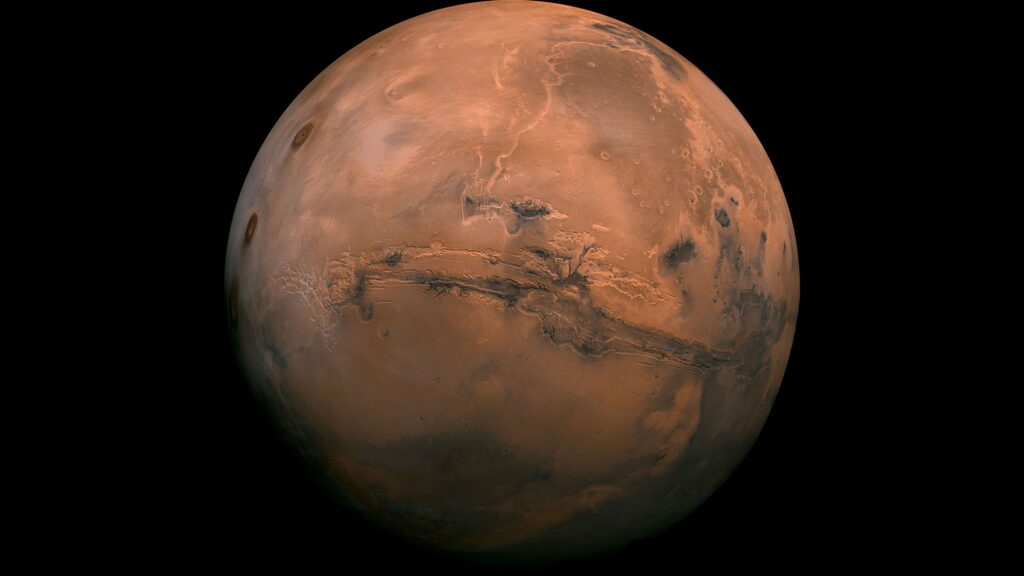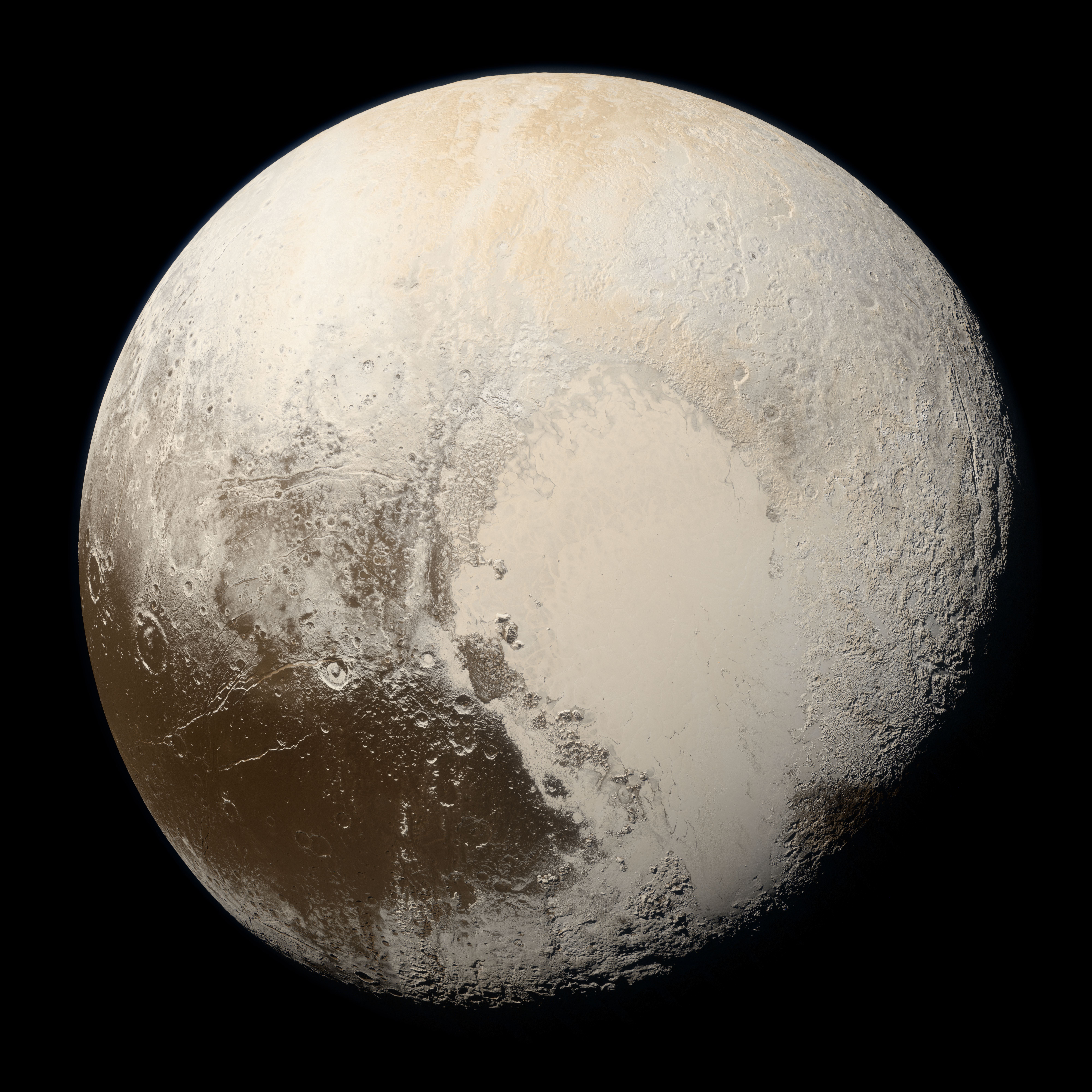Table of Contents
Birth of a Planet
Mars came into existence approximately 4.5 billion years ago, forming from a vast, rotating disk of gas and dust that also gave rise to the Sun and the rest of the solar system. As particles clumped together, gravity shaped the young planet into a spherical body, with intense collisions generating immense heat. This process, known as planetary accretion, created a molten world with a dynamic interior. Initially, its core was thought to be highly active, producing a strong magnetic field that shielded the planet from harsh solar winds. However, unlike Earth, it cooled rapidly, significantly slowing geological activity and marking the beginning of its atmospheric decline.
As internal heat dissipated, the mars experienced a weakening magnetic field, which had dramatic consequences for its environment. Without this protective shield, solar radiation began stripping away its atmosphere, thinning it over millions of years. This loss reduced the planet’s ability to retain heat, eventually transforming it into the cold, barren world seen today. Scientists believe this early cooling also impacted volcanic activity, preventing long-term plate tectonics that help regulate a planet’s climate. While evidence of an active core persists, the lack of sustained geological movement suggests that the planet’s fate was sealed long ago, leaving only traces of its once-dynamic past.
A Watery Past Buried in Time
Mars was once a planet shaped by flowing rivers, vast lakes, and possibly entire oceans, marking a stark contrast to the barren landscape observed today. Geological evidence collected from orbiters and rovers has revealed winding river channels, layered sedimentary rocks, and ancient deltas—clear indicators of prolonged liquid water activity. The presence of minerals such as clays and sulfates further supports the theory that liquid water persisted for millions of years. Some studies suggest that an ocean may have once covered much of the planet’s northern hemisphere, creating a stable and potentially habitable environment. However, the loss of atmospheric pressure gradually made it impossible for surface water to exist in liquid form.
Over time, the mars experienced a drastic transformation as its atmosphere thinned and its weak gravity failed to retain essential gases. With reduced atmospheric insulation, temperatures dropped, causing any remaining water to freeze or escape into space. Today, the polar ice caps contain vast reserves of frozen water, while radar scans have detected possible underground lakes beneath layers of dust and rock. Though no definitive signs of life have been found, the past presence of liquid water continues to fuel speculation that microbial organisms may have once thrived—and could still survive in hidden subsurface environments.
A Vanishing Shield and a Frozen World
Mars once had a thick, life-supporting atmosphere that allowed liquid water to flow freely across its surface, but over time, it suffered an irreversible transformation. Scientists believe that in its early years, the planet’s atmosphere was rich in greenhouse gases, possibly creating a climate warm enough to sustain lakes and rivers. However, the gradual loss of its magnetic field left it vulnerable to relentless solar winds, which stripped away much of the protective atmospheric layer. Without sufficient pressure to keep water in liquid form, evaporation accelerated, and moisture was lost to space. This atmospheric decline, coupled with reduced volcanic activity, left the planet exposed to the harsh conditions seen today.
With only a thin layer of carbon dioxide remaining, the mars now endures an extreme and unforgiving climate. The lack of atmospheric density results in drastic temperature swings, with daytime highs barely reaching above freezing and nighttime temperatures plunging to -195°F (-125°C). Dust storms frequently engulf the planet, sometimes lasting for months, further shaping its desolate terrain. Without a significant greenhouse effect, heat escapes rapidly, preventing the surface from warming enough to sustain life as we know it. Although modern rovers have detected trace amounts of methane, a potential biosignature, the hostile environment makes the search for life incredibly challenging.
The Surface and Its Striking Red Color
Mars is a world of breathtaking geological contrasts, dominated by vast plains, towering peaks, and deep chasms that rival anything found on Earth. Its surface is coated in iron-rich dust, which, when exposed to oxygen, undergoes oxidation—essentially a rusting process—that gives the planet its distinct red hue. This fine dust blankets the entire surface, carried by powerful winds that fuel planet-wide dust storms. The terrain is a mix of ancient impact craters, wind-sculpted dunes, and hardened lava flows from long-extinct volcanoes. The reddish tint extends beyond the soil, with even the sky often appearing dusty pink due to the scattering of fine iron particles suspended in the thin atmosphere.
Among the mars’ most astonishing features is Olympus Mons, the largest volcano in the solar system, standing nearly 72,000 feet (22 km) tall—nearly three times the height of Mount Everest. Its base spans roughly the size of France, a testament to the planet’s once-active volcanic history. Equally impressive is Valles Marineris, a canyon system stretching over 2,500 miles (4,000 km), making it the largest canyon in the solar system. If placed on Earth, it would stretch across the entire United States. These immense formations highlight the planet’s violent geological past, shaped by volcanic activity, tectonic forces, and meteorite impacts that have sculpted the Martian surface into the rugged world we observe today.
A Core Shrouded in Uncertainty
The internal structure of Mars remains a subject of ongoing investigation, with its core composition providing valuable clues about its geological evolution. Made primarily of iron, nickel, and sulfur, the core is significantly smaller in proportion to the planet’s size than Earth’s. While seismic readings suggest it could be at least partially molten, its lack of a strong magnetic field indicates it is no longer generating the heat-driven convection seen in Earth’s core. This absence of sustained magnetic activity left the planet vulnerable to solar winds, contributing to atmospheric loss. Scientists continue to analyze data from landers like InSight to determine the precise state of this hidden and enigmatic metallic sphere.
Surrounding the core, the silicate mantle of Mars once played a crucial role in shaping the planet’s surface. In its early history, this mantle was responsible for significant volcanic activity, helping to form the extensive basaltic plains observed today. However, as the mantle cooled, geological activity slowed, and tectonic movement became virtually nonexistent. The outermost layer, the crust, is much thicker than Earth’s, making it more resistant to changes over time. Primarily composed of basaltic rock, the planet’s surface shares similarities with Earth’s oceanic crust, suggesting widespread volcanic processes in the past. These ancient formations provide insight into a planet that was once far more geologically active than it is today.
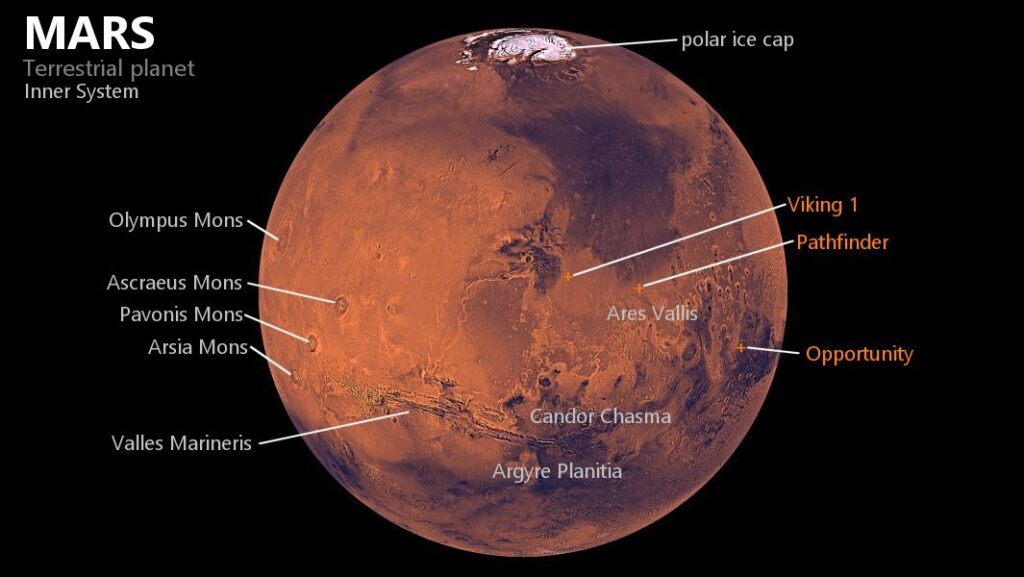
Two Moons, Two Destinies
The two moons of Mars, Phobos and Deimos, are small, irregularly shaped celestial bodies that orbit the planet at different distances. Scientists believe they were once asteroids from the main asteroid belt, captured by the planet’s gravity billions of years ago. Unlike Earth’s nearly spherical moon, these moons are heavily cratered and lumpy, resembling space debris rather than large planetary satellites. Phobos, the larger of the two, orbits just 3,700 miles (6,000 km) above the surface, making it the closest moon to its planet in the solar system. Due to this proximity, it completes an orbit in just 7 hours and 39 minutes, appearing to rise and set multiple times a day.
While Phobos moves closer to Mars each year, slowly spiraling inward, Deimos is on the opposite trajectory. Positioned over 14,500 miles (23,500 km) away, Deimos orbits at a much slower pace, taking approximately 30 hours to circle the planet. Over millions of years, it is gradually drifting farther away, possibly escaping the planet’s gravitational influence entirely. If Phobos continues its descent, it will either crash into the surface or break apart, forming a temporary ring around Mars. These moons, though small and unremarkable in appearance, offer critical insights into planetary capture, orbital decay, and the dynamic forces that shape the Martian system over time.
From Myth to Science
For centuries, Mars has fascinated observers, with ancient civilizations documenting its movements across the night sky. The Babylonians recorded its path with great precision, while the Greeks and Romans named it after their respective gods of war due to its blood-red color. Early telescopic observations in the 17th century revealed its polar ice caps, fueling speculation about its similarities to Earth. By the 19th century, astronomers such as Giovanni Schiaparelli described seeing what appeared to be linear features on its surface, which he called “canali.” This term, later mistranslated as “canals,” led to widespread theories that an intelligent Martian civilization had constructed vast waterways to distribute dwindling water supplies.
As telescopic technology improved, the mars-based canal theory was debunked, but the search for extraterrestrial life continued. In the mid-20th century, spacecraft like Mariner 4 provided the first close-up images of a barren, cratered surface, contradicting hopes of lush landscapes. Later, the Viking landers conducted direct experiments on Martian soil, searching for biological activity but finding no definitive signs of life. Today, modern rovers and orbiters analyze soil composition, methane emissions, and subsurface ice in the ongoing quest to determine if microbial life once thrived—or still exists—beneath the surface. The mystery of life on Mars remains one of the most compelling questions in planetary science.
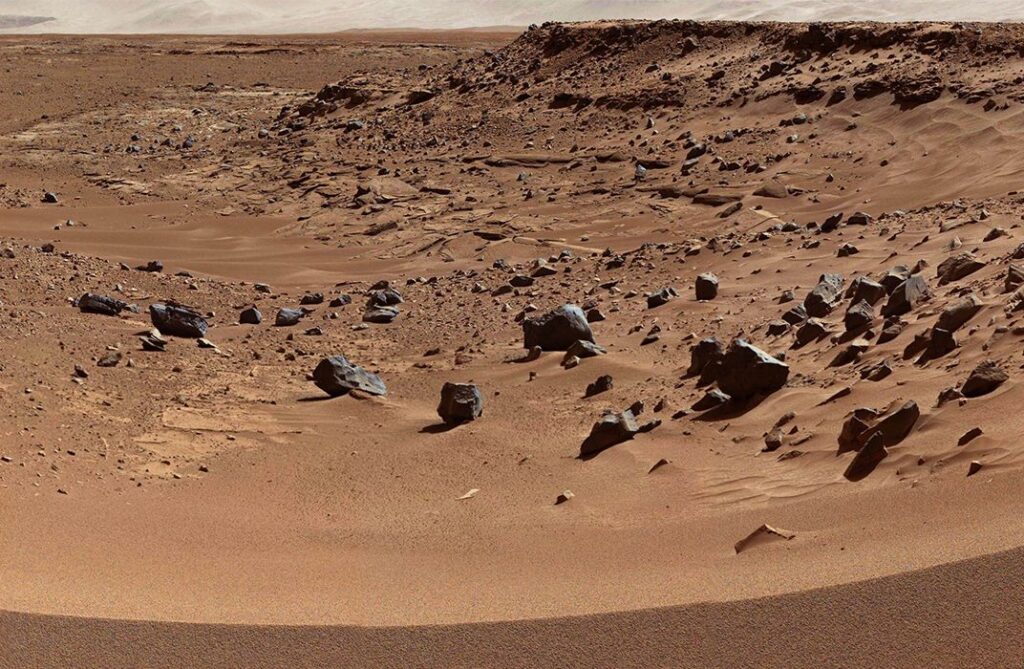
Unraveling a Planet’s Secrets
The robotic exploration of Mars began in the 1960s, with early flyby missions providing humanity’s first close-up views of the planet. In 1976, NASA’s Viking 1 and Viking 2 landers made history by transmitting the first surface images and conducting experiments to detect biological activity. While their findings were inconclusive, they paved the way for future missions. Over the decades, increasingly advanced rovers have transformed the study of the Martian environment. Opportunity and Spirit uncovered evidence of past water, while Curiosity analyzed atmospheric composition and radiation levels. More recently, Perseverance landed in Jezero Crater, where it is collecting rock samples and deploying the experimental Ingenuity helicopter to scout the terrain.
As technology progresses, the mars exploration program has shifted toward preparing for human missions. Rovers and landers are testing soil composition, searching for potential water sources, and analyzing weather patterns to determine survivability. One of the most ambitious goals is the Mars Sample Return mission, which will bring soil and rock samples to Earth for detailed study. Future missions may include sending astronauts to establish a base camp, with companies like SpaceX working on spacecraft capable of long-duration travel. While challenges such as radiation exposure and resource limitations remain, each new mission brings humanity closer to turning Mars into a destination for exploration—and possibly even colonization.
Turning a Barren World into a Second Earth
Terraforming Mars has long been a topic of scientific debate and science fiction dreams, with researchers exploring ways to make the planet more habitable. Some proposals suggest releasing massive amounts of greenhouse gases, such as carbon dioxide from the polar ice caps, to trigger a warming effect and restore liquid water. Others envision placing giant space mirrors in orbit to reflect sunlight onto the surface, gradually increasing temperatures. Another idea involves importing ammonia-rich asteroids to create a thicker atmosphere. However, even if these methods were successful, they would require centuries to significantly alter the climate, and the sheer scale of the project makes it one of the most daunting challenges in planetary engineering.
Despite ambitious proposals, the mars remains fundamentally inhospitable due to two major obstacles: weak gravity and the absence of a strong magnetic field. Without sufficient gravity, any newly thickened atmosphere would gradually escape into space, undoing centuries of terraforming efforts. Additionally, the lack of a magnetic shield leaves the planet vulnerable to solar winds, which continuously strip away atmospheric particles. Even if an Earth-like climate could be achieved temporarily, sustaining it would require ongoing technological interventions. Given these challenges, many scientists argue that rather than attempting full-scale terraforming, efforts should focus on building self-sustaining habitats, where future explorers could survive within protective enclosures rather than reshaping the entire planet.
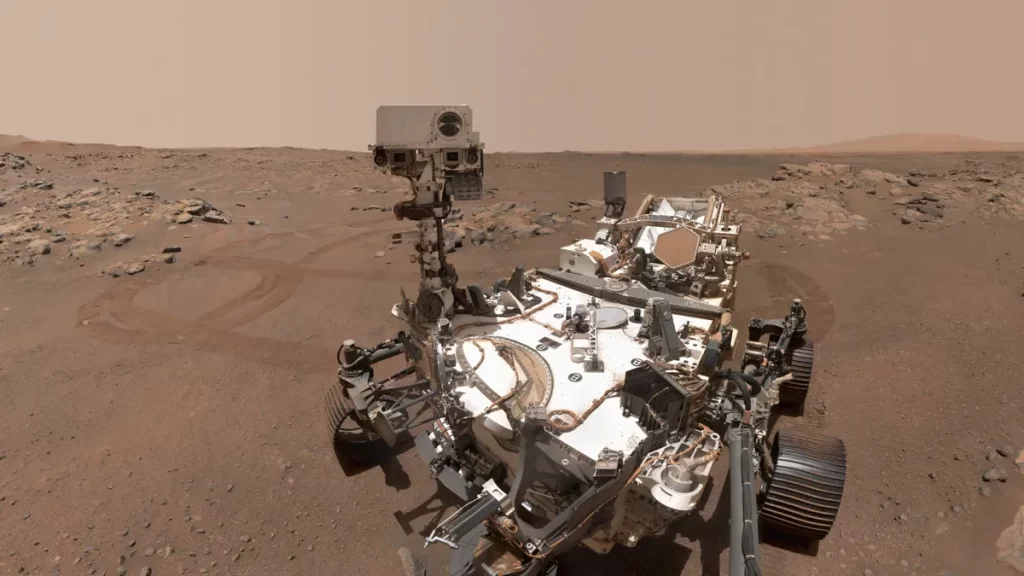
Building a Future Beyond Earth
The idea of colonizing Mars has transitioned from science fiction to a serious long-term goal for space agencies and private companies. Its proximity to Earth, availability of water ice, and potential for resource utilization make it the most practical candidate for human settlement. SpaceX, led by Elon Musk, has proposed using reusable Starship rockets to transport large numbers of settlers, while NASA’s Artemis and Moon-to-Mars programs aim to establish sustainable deep-space travel. To survive, colonists will need enclosed habitats with advanced life-support systems, hydroponic farms for food production, and efficient methods for extracting oxygen and water. These technologies are rapidly advancing, bringing humanity closer to setting foot on the Red Planet.
However, surviving on the mars presents extreme challenges that must be addressed before colonization can become a reality. Without a protective atmosphere, astronauts would face high levels of cosmic radiation, requiring underground shelters or shielding technology. The planet’s lower gravity—just 38% of Earth’s—could have unknown long-term health effects. Psychological strain from prolonged isolation, communication delays, and resource scarcity could also impact mission success. While robotics and artificial intelligence may assist in reducing risks, full-scale colonization will require an unprecedented level of planning and international cooperation. Despite these obstacles, continued advancements in aerospace technology and habitat engineering make the dream of a Martian colony an increasingly realistic possibility.
The Ongoing Search for Life Beyond Earth
For centuries, Mars has been the prime candidate in the search for extraterrestrial life, fueling both scientific research and public fascination. Early telescope observations led to speculation about intelligent civilizations, but modern exploration has shifted focus to microbial life. The discovery of dried riverbeds, ancient lake basins, and hydrated minerals suggests that the planet once had conditions suitable for life. One of the most compelling pieces of evidence comes from the detection of methane in its atmosphere. On Earth, methane is primarily produced by biological processes, though geological activity can also be a source. The fluctuating levels of methane observed by rovers like Curiosity raise intriguing questions about whether microbial life still exists beneath the surface.
If life ever existed on the mars, many scientists believe it would have retreated underground, where subsurface water might still remain. Harsh surface conditions, including intense radiation and extreme cold, make it unlikely for organisms to survive on the surface today. However, underground caves or aquifers could provide stable environments for extremophiles—microorganisms capable of surviving in extreme conditions. Future missions, including the European Space Agency’s ExoMars rover and proposed drilling projects, aim to explore deeper layers of the crust in search of biosignatures. While no definitive proof has been found yet, each discovery brings us closer to answering the age-old question: Are we alone in the universe?
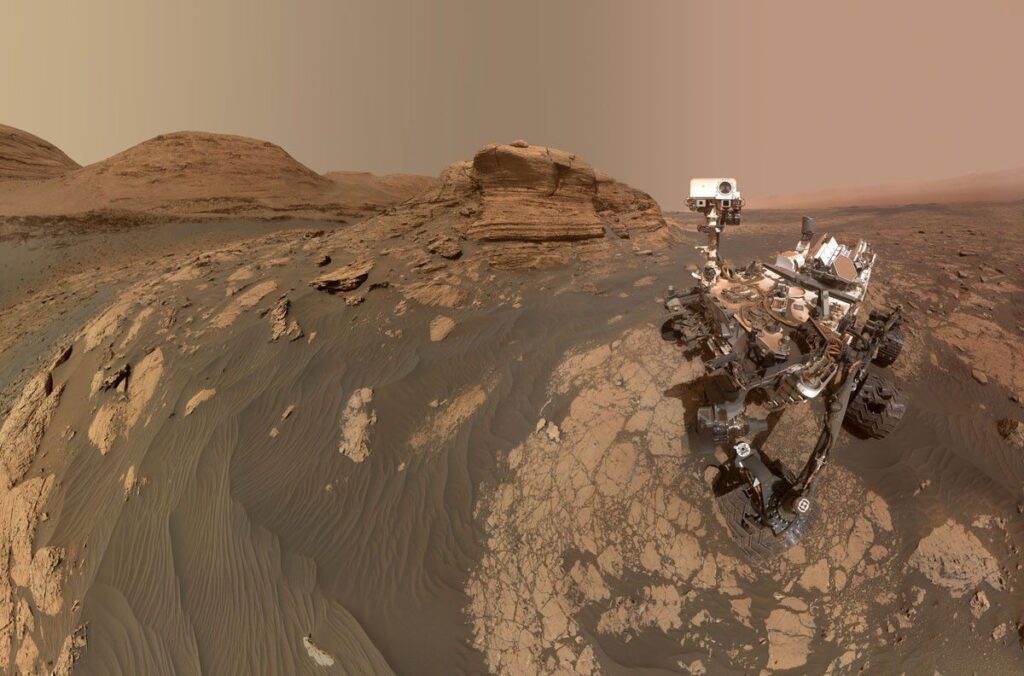
Expanding Humanity’s Reach into the Cosmos
The next phase of Mars exploration will focus on retrieving samples, testing new technologies, and preparing for human missions. NASA and the European Space Agency’s Mars Sample Return mission aims to bring back rock and soil for analysis, searching for signs of past life. Meanwhile, advancements in propulsion could shorten travel time, and robotic outposts may test resource extraction, such as mining water ice or producing oxygen from the carbon dioxide-rich atmosphere. Private companies and space agencies are also developing habitat designs to support future astronauts. These efforts will lay the groundwork for sustained exploration and, eventually, the possibility of a permanent human presence on the Red Planet.
As technology advances, the mars may serve as humanity’s first outpost beyond Earth, paving the way for deeper space exploration. Some scientists envision Mars as a refueling station for missions to the outer solar system, including the icy moons of Jupiter and Saturn, which may harbor subsurface oceans capable of supporting life. Others speculate that the knowledge gained from surviving on Mars could one day help humans prepare for interstellar travel. Whether the planet becomes a second home or remains a research station on the edge of human expansion, its role in shaping the future of space exploration is undeniable.
How useful was this post?
Click on a star to rate it!
Average rating / 5. Vote count:
No votes so far! Be the first to rate this post.
Author
-
Meet Dr. Kendall Gregory, a highly accomplished professional with a remarkable academic background and a deep passion for empowering individuals through knowledge. Dr. Gregory’s educational journey began with a Bachelor of Science degree, followed by a Doctor of Chiropractic Medicine, focusing on diagnosing and treating musculoskeletal conditions. He further expanded his expertise with a Master's degree in Oriental Medicine, specializing in acupuncture and Chinese herbology, and a Master's degree in Health Care Administration, emphasizing his dedication to improving healthcare systems. Dr. Gregory combines his extensive knowledge and practical experience to provide comprehensive and integrative healthcare solutions. Through his writings, he aims to inspire individuals to take charge of their health and make informed decisions.
View all posts

